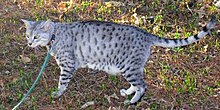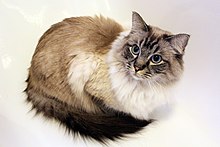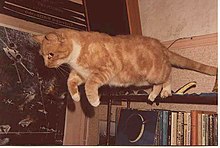Tabby

Tabby describes the typical fur drawings of cats when the cat is not monochrome or monochrome with white. The patterns are tiger, brindle, spotted and ticked .
The tabby patterns

All tabby patterns have in common an M-shaped drawing on the forehead in the basic color. Further characteristics for the presence of a drawing are a lighter outline around the eyes, also known as "tabby glasses", and a lighter outline around the ears. Some red cats in particular are often incorrectly referred to as "tabby", although they are genetically non-agouti , i.e. actually free of drawings, since the actually suppressed drawing as " ghost drawing " can still be clearly visible in them. The rims around the eyes and ears can be helpful indicators for recognizing the tabby.
Mackerel
The tabby drawing ( English Mackerel ) corresponds to the wild type. The cat has a dark eel line along the spine and narrow dark stripes that run down the sides of the body. Tail and legs are curled.
Brindle
The brindle drawing (English Classic or Blotched ) is a mutation of the tabby drawing. The dark stripes are broadened and there is a butterfly drawing on the shoulders. There is a dark spot in the middle of each flank. Farmers in Europe preferred brindle cats because then they could be sure that they were not hard-to-keep wild cats . That is why European house cats are brindle very often.
Spotted
In the drawing spotted (English spotted ), the tiger stripes are dissolved in points.
Ticked
The ticked drawing (also known as agouti ) is characteristic of some cat breeds such as the Abyssinian cat , Ceylon cat, and Singapura . Each hair of the cat is banded several times light and dark, whereby the pattern is completely dissolved and the cat appears monochrome.
More patterns
African tabby
This pattern is known from the Sokoke cat and is a modification of the brindle drawing.
Rosette pattern
The rosette pattern has been transferred to domestic cats through crossing with the Asian Bengal cat. The ring-shaped spots with a light interior are reminiscent of the fur pattern of the leopard .
Genetic bases
The gene responsible for drawing is also called a tabby. Various genes, including the non-agouti allele of the agouti gene (a) and the gene for white coloring (W), obscure the tabby pattern.
According to recent genetic research, at least 3 genes are involved in the formation of the tabby drawing:
- The ticked locus (Ti) is on the cat chromosome B1. The gene is incompletely dominant, with mixed inheritance the cat still has a ring mark on the legs and tail.
- The tabby locus is on the cat chromosome A1. The tabby locus is responsible for tiger stripes or currents, with the striped pattern being dominant. An older result locating the “tabby locus” on B1 identified the tabby locus with the ticked locus.
- A third locus is responsible for the polka dot pattern in the Egyptian Mau . The gene is incompletely dominant, with mixed inheritance the cats show a pattern with interrupted stripes or deformed spots.
Every cat has a gene for one of these tabby patterns, even if it appears monochrome. Various genes, including the non-agouti allele of the agouti gene (a) and the gene for white coloring (W), mask the tabby pattern. Young animals often still have a ghost mark in their single-colored fur, which then disappears in adult cats. On the other hand, in the case of red cats that carry the non-agouti allele genetically, which should therefore be free of drawings, its effect is reduced so that a drawing is still visible.
According to a study of historical cat DNA presented in September 2016, the mutation responsible for the brindle tabby pattern did not appear before the Middle Ages.
literature
- Dagmar Thies: Breeding pedigree cats . Kosmos Verlag, ISBN 3-440-10128-2 .
Web links
Individual evidence
- ↑ a b Eduardo Eizirik, Victor A. David, Valerie Buckley-Beason, Melody E. Roelke, Alejandro A. Schäffer, Steven S. Hannah, Kristina Narfström, Stephen J. O'Brien, Marilyn Menotti-Raymond: Defining and mapping mammalian coat pattern genes: multiple genomic regions implicated in domestic cat stripes and spots In: Genetics Oct. 2009, 184, pp. 267-275
- ↑ LA Lyons et al .: The Tabby cat locus maps to feline chromosome B1. In: Anim Genet. Aug 2006/37 (4), pp. 383-386, PMID 16879352 .
- ↑ Ewen Callaway: How cats conquered the world (and a few Viking ships) . Nature , September 20, 2016. German translation: How cats conquered the world (and a few Viking ships) . Spectrum of Science , September 23, 2016. Both sources accessed on September 24, 2016.




